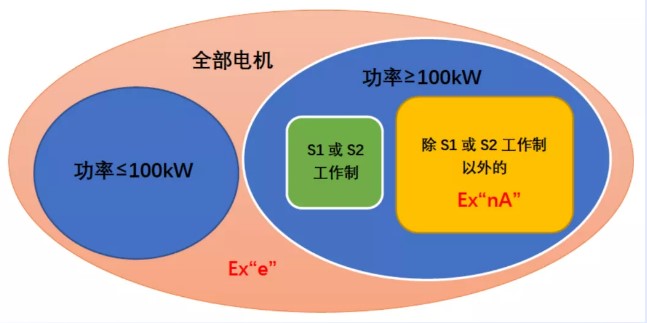Increased safety type"E"Electric motors and spark free modelsNAThe general structure of the motor is very similar, even in terms of testing items and inspection requirements. Many people cannot accurately distinguish the requirements of these two types of explosion-proof motors. Here is a simple comparison, in order to provide insights for further exploration of these two types of motorsexplosion-proofThe difference between motors.
Explosion proof type definition
“E "Increased safety typeTake additional measures for electrical equipment to improve safety and prevent the possibility of dangerous temperatures, arcs, and sparks during normal operation or specified abnormal conditions.
“NASpark free device: a device structurally designed to minimize the risk of generating arcs or sparks that can cause ignition under normal usage conditions.
From this perspective, it can be simply said that increased safety motors can prevent arcs and sparks from occurring during operation, whileNAAlthough the type is called spark free, it cannot completely prevent and eliminate sparks, but only minimizes them to the greatest extent possible.NAThe device can reduce the probability of sparks, so low that the risk of triggering them can reach an acceptable level for people. It is not difficult to understand why the standard stipulates that some increased safety motors (under specific conditions) can achieveGbLevel, while non spark motors can only beGcLevel.
Comparison of structural and performance requirements
1. Increased safety motors (using current protection devices to prevent exceeding the limit temperature) have a proportional starting current ratioIA/INandTEThe time requirement should be indicated on the motor nameplate to facilitate the selection and configuration of appropriate protective devices when using the motor, while non spark motors do not require it.
Both increased safety and non spark motors have requirements for electrical clearance and creepage distance, but at the same voltage level, the minimum electrical clearance and creepage distance between live parts of increased safety motors are larger than those of non spark motors (see table for details) 1)And the material level of the insulation components used in spark free motors can be as low asIIIbLevel, while increased safety motors require the use ofIIIaAnd above.

surface 1 Voltage level≤ 250VDifferent requirements for creepage distance and electrical clearance between time increasing safety and spark free types
3. Requirements for squirrel cage rotors,Increased safety motors require comparisonGB3836.3-2010surface4The potential air gap spark hazard assessment for squirrel cage rotor ignition hazard factors is evaluated, while for non spark motors, only rated output greater than100kWS1orS2Only motors that are excluded from the working system need to comply with theGB3836.8-2014surface6Evaluation of potential air gap spark hazards for ignition hazards of squirrel cage rotors (see differences in figure)1)Then decide whether additional measures need to be taken to ensure that the motor does not explode during start-up and operation.

chart1 Range of motors that require air gap spark hazard assessment for increased safety and non spark types
4. For the requirements of the stator winding insulation system,Rated voltage exceeds1kVThe increased safety type motor should be equipped with special protection measures to ensure that its casing does not contain explosive gases during startup, while the non spark type motor does not have this requirement. It is only recommended to minimize the partial discharge of the high-voltage winding for rated voltage≥ 6.6 kVIt is recommended to use materials that can suppress partial discharge for the winding.
Comparison of test requirements
Increased safety type (rated voltage exceeding1kVAll motors and non spark type (with a rated voltage greater than that of the loose wound stator)1kVOr the rated voltage of the mold wound stator is greater than6.6kVofIIAClass and rated voltage greater than1kVofIIBandIICAll motors are subjected to steady-state ignition tests on the stator winding insulation system, but the rated voltage exceeds1kVAn increased safety motor also needs to be operated in a specified explosive gas mixture3Twice the peak phase to ground voltage10Transient ignition test with voltage pulses.Increased safety motors require insulation dielectric strength testing, while spark free motors do not have specific regulations for insulation dielectric strength testing.